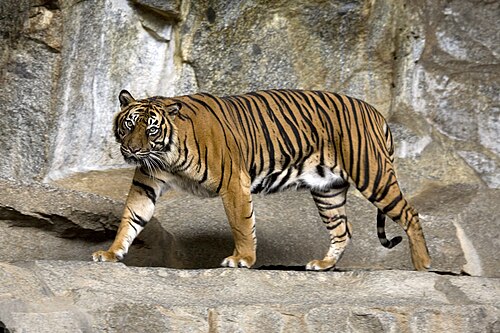Panthera tigris sumatrae

The Sumatran tiger is a carnivore belonging to the genus Panthera in the family Felidae. Its small size allows it to swiftly traverse dense forests. It has deep orange fur with dense stripes; the black stripes are wider, with small gaps between them, often arranged in pairs; it also has stripes on its forelegs, long cheek hair, long whiskers, and dense fur all over its body; females are smaller and lighter than males.
Sumatran tigers mainly live in the tropical rainforests of the Sumatra archipelago, and their range depends on the density of prey and the size of their habitat. Their habitat ranges from plains forests to mountains. They hide during the day and hunt at night. [9] Their main food is sambar deer, wild boar, porcupine, crocodile, python, young rhinoceros and young elephant. Sumatran tigers in the rainforest mainly rely on ambushes to attack their prey. They can mate all year round, with late winter and early spring being the most concentrated mating seasons. The gestation period for female tigers is about 103 days, and they give birth to 2 to 4 cubs per litter. The longest lifespan in the wild is 15 years, and the longest lifespan in captivity is 20 years.
The Sumatran tiger is the smallest of the extant tiger subspecies. Due to human encroachment and destructive exploitation of natural resources, its habitat has been continuously reduced and fragmented. The establishment of a factory by the Asia Pulp & Paper Corporation on Sumatra Island, leading to extensive deforestation, has resulted in significant habitat loss for the Sumatran tiger. Overhunting has also pushed them to the brink of extinction. Tiger hunting has been rampant in Sumatra, and the rapid increase in the population migrating to the island has further exacerbated human-tiger conflict. The Sumatran tiger is listed as Critically Endangered (CR) on the IUCN Red List of Threatened Species, with approximately 400-500 individuals remaining in the wild.





